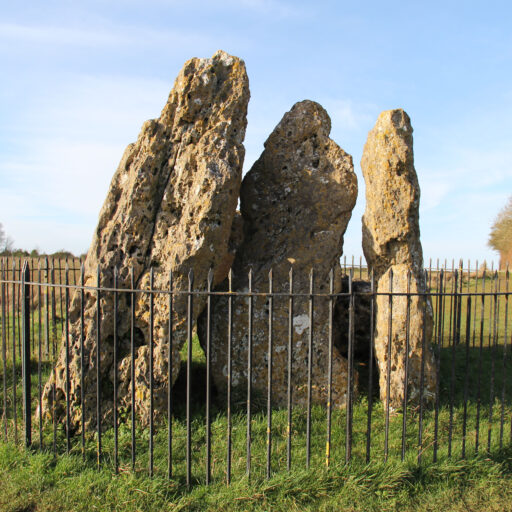The Rollright Stones are located on the border of Warwickshire and Oxfordshire, near the village of Little Rollright. They have stood since the Neolithic era and their history spans over 5,500 years.
Their story starts with the construction of The Whispering Knights, a Neolithic Dolmen [a single chamber tomb], it is even believed that this is one of the earliest burial monuments in the UK. It would have been erected by some of the earliest farming peoples to settle in the area.
The site was used from the Neolithic era right up to the Bronze Age in regards to burials. The cap stone has long since fallen and now rests to the side of the standing stones. The Whispering Knights contains the tallest stone of all the Rollright monuments.
The stones lean into one another, as if they are crowed together; plotting. Legend is that the King’s knights were conspiring against him, the witch of Long Compton turned them to stone before they could carry out their plan to overthrow the King. Although, another tale is that the knights were praying as they were turned to stone by the witch.
It is also said that on New Year’s Day, the Whispering Knights awaken to visit the brook in a near by valley and drink from it.
The King’s Men is the stone circle which dates from the Bronze Age. There are around 70 stones, although it is believed that there once was over 100. It is said to be impossible to count the stones, but if you count the same number three times, you are granted one wish.
The King’s Men takes its name from the local legend. A King was marching his army across England, when they were challenged by the witch of Long Compton. He wanted to conquer England in his name, but she would ensure this would not come to pass. The witch proclaimed, “Seven long strides shalt thou take and if Long Compton thou canst see, King of England thou shalt be!” to which the King replied, “Stick, stock, stone. As King of England I shall be known!”
Upon the King’s seventh stride, the ground before him rose up to obstruct his path. The witch bellowed, “As Long Compton thou canst not see, King of England thou shalt not be. Rise up stick and stand still stone, for King Of England thou shall be none. Thou and thy men hoar stones shall be, and myself an Eldern tree!”
The witch, as true to her word, turned the King and all of his men to stone. She, as an eldern tree, watches over the King’s men. It is not known why the witch wanted to stop the King in his tracks. Did she know something he did not? Was she protecting him? It is said that one day, when the King and his men are needed for battle once more, the spell will be broken.

Aerial view of The Rollright stones, taken by Nick Turner
It is possible that some of the stones were removed in more modern times and reused for other constructions, as is common for standing stones. It is said that the largest stone was taken by a local farmer in order to be used as a bridge over a stream on his land. It took 24 horses to drag this stone, but the stone had cursed him. A farm hand was killed on the way back and once the stone had been placed over the stream, it was found to have fallen in the next day. It was put back in place, but this happened repeatedly, and so the farmer and his horse dragged it back. Taking the stone back required just one horse; perhaps the stone knew it was returning and lifted it’s curse on the foolish farmer.
The King’s Stone is believed to be a Bronze Age burial marker, burial mounds and cairns have been discovered on the site nearby. Cremated remains were found to be marked with wooden pillars. The stone is said to have been an important meeting place during Saxon times. The grave of a 7th century high priestess was found not a few hundred yards away. It is relatively common for ancient monuments to be re-purposed by cultures down the line. Even today, the Rollright Stones have become an important place for new age and more traditional Pagans.
The shape of The King’s Stone has changed over time, much like the other monuments. Whilst weathering has had an impact, the main cause of the peculiar shape of the King’s Stone was down to treasure hunters. During the 19th century, Victorian tourists were notorious for chipping off parts of the stone as a memento. It is also said that a piece of the King’s Stone on your person would keep the Devil away.
The mound behind the King’s Stone is said to be the one that blocked his view of Long Compton. This is where the King has stood, frozen in time. He watches over his men, waiting for the spell to be broken.
The Rollright Trust have the opportunity to finally reunite the King with his men. They have been given the chance to purchase the land from Haine Farmers. If you would like to donate a few pounds, you can do so here. There is also a petition to try and save the Rollright Stones from traffic disruption, if you can sign it here.
All photos are my own unless otherwise stated.












